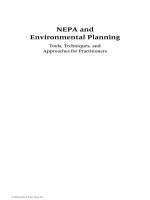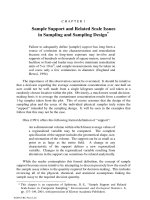questions for chapter 1
Bạn đang xem bản rút gọn của tài liệu. Xem và tải ngay bản đầy đủ của tài liệu tại đây (28.1 KB, 4 trang )
1) The Sarbanes-Oxley Act applies to which of the following companies?
A) All companies
B) Privately held companies
C) Public companies
D) All public companies and privately held companies with assets greater than $500 million
2) Which of the following is considered audit evidence?
A)
Oral statements
Written
Auditor
made by management Communications
Observation
Y
N
N
B)
Oral statements
made by management
N
Written
Communications
Y
Auditor
Observation
Y
Written
Communications
Y
Auditor
Observation
Y
Written
Communications
N
Auditor
Observation
Y
C)
Oral statements
made by management
Y
D)
Oral statements
made by management
N
3) Recording, classifying, and summarizing economic events in a logical manner for the purpose
of providing financial information for decision making is commonly called:
A) finance.
B) auditing.
C) accounting.
D) economics
4) An accountant:
A) must possess expertise in the accumulation of audit evidence.
B) must decide the number and types of items to test.
C) must have an understanding of the principles and rules that provide the basis for preparing the
accounting information.
D) must be a CPA.
5) In "auditing" financial accounting data, the primary concern is with:
A) determining whether recorded information properly reflects the economic events that
occurred during the accounting period.
B) determining if fraud has occurred.
C) determining if taxable income has been calculated correctly.
D) analyzing the financial information to be sure that it complies with government requirements.
6) The trait that distinguishes auditors from accountants is the:
A) auditor's ability to interpret accounting principles generally accepted in the United States.
B) auditor's education beyond the Bachelor's degree.
C) auditor's ability to interpret FASB Statements.
D) auditor's accumulation and interpretation of evidence related to a company's financial
statements.
7) ________ risk reflects the possibility that the information upon which the business decision
was made was inaccurate.
A) Client acceptance
B) Information
C) Business
D) Control
8) A correct relationship among the auditor, the client, and the external users is:
A) management of a public company hires the independent auditor.
B) the audit committee of a private company hires the independent auditor.
C) the client provides capital to the external users.
D) the external users can rely upon the auditor's report to reduce information risk.
9) The most common way for users to obtain reliable information is to:
A) have an internal audit.
B) have an independent audit.
C) verify all information individually.
D) verify the information with management.
10) Any service that requires a CPA firm to issue a report about the reliability of an assertion that
is made by another party is a(n):
A) accounting and bookkeeping service.
B) attestation service.
C) assurance service.
D) tax service.
11) Which of the following services provides the lowest level of assurance on a financial
statement?
A) A review
B) An audit
C) Neither service provides assurance on financial statements.
D) Each service provides the same level of assurance on financial statements.
12) One objective of an operational audit is to:
A) determine whether the financial statements fairly present the entity's operations.
B) determine if the auditee is in compliance with GAAP.
C) make recommendations for improving performance.
D) report on the entity's relative success in attaining profit maximization.
13) An examination of part of an organization's procedures and methods for the purpose of
evaluating efficiency and effectiveness is what type of audit?
A) Operational audit
B) Compliance audit
C) Financial statement audit
D) Production audit
14) An audit to determine whether an entity is following specific procedures or rules set down by
some higher authority is classified as a(n):
A) audit of financial statements.
B) compliance audit.
C) operational audit.
D) production audit.
15) Which one of the following is more difficult to evaluate objectively?
A) Presentation of financial statements in accordance with generally accepted accounting
principles
B) Compliance with government regulations
C) Efficiency and effectiveness of operations
D) All three of the above are equally difficult.
16) Which of the following are required to have a written report regarding the assertion of
another party?
A)
Financial
Statement
Operational Compliance Attestation
Assurance
Audit
Audit
Audit
Engagement Engagement
Y
Y
Y
Y
Y
B)
Financial
Statement
Audit
Y
Operational
Audit
Y
Compliance
Audit
Y
Attestation
Engagement
Y
Assurance
Engagement
N
Financial
Statement
Audit
Y
Operational
Audit
Y
Compliance
Audit
Y
Attestation
Engagement
N
Assurance
Engagement
N
Operational
Compliance
Attestation
Assurance
C)
D)
Financial
Statement
Audit
N
Audit
N
Audit
N
Engagement
Y
Engagement
Y
17) An auditor must be competent and have an independent mental attitude.
A) True
B) False
18) The criteria used by an external auditor to evaluate published financial statements are known
as generally accepted auditing standards.
A) True
B) False
12) CPA firms are never allowed to provide bookkeeping services for clients.
A) True
B) False
19) Evidence is paramount to audit and attestation engagements. List the four basic types of audit
evidence.
20) Two types of attestation services provided by CPA firms are audits and reviews. Discuss the
similarities and differences between these two types of attestation services. Which type provides
the least assurance?









